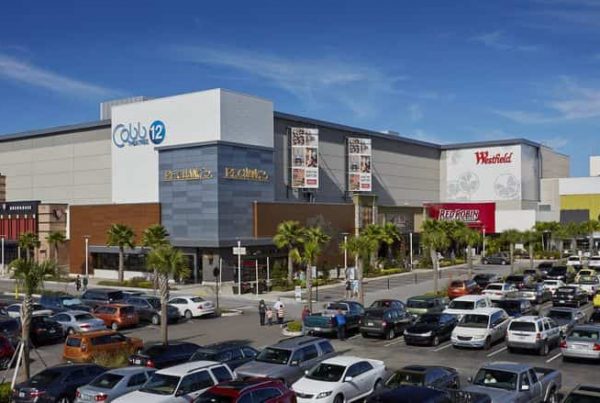Consensus is growing in the shopping center industry, experts say, about two key realities of the omni-channel age: The first is that sales per square foot no longer measures the full value of all stores and malls; the second is that retailers and landlords have made scant progress toward replacing it. “People are wringing their hands about this,” said Rachel Elias Wein, president of real estate consultancy WeinPlus. “But nobody knows quite what to do.”
To be sure, it still makes sense to rely on sales per square foot if the transactions in question happen at cash registers rather than on computers or mobile devices, observers say, but retailers with robust e-commerce programs increasingly use brick-and-mortar stores in ways that confound timeworn approaches to valuing real estate.
And yet, by operating stores at landlords’ high-traffic properties, retailers benefit in ways that boost their own bottom lines: They can acquire loyal customers for a lifetime, ramp up brand recognition, run click-and-collect programs, speed up last-mile delivery, bolster online sales through showroom-style merchandising, or rack up impulse buys from the shoppers who return their online purchases at stores.
Unlike cash-register transactions, the value of such uses can be tough to measure — and that can leave retailers and landlords alike trying to figure out how much a store or mall is worth, says Wein. “Everyone would love to have better insight into this, but in many cases it’s virtually impossible to show causation,” she said. “Let’s say someone buys a red sweater online. It could be because they tried it on inside the store while on a trip to the mall. Or it could be because that was the 17th time that Google marketed it to them on their phone. So how do you know?”

Mindful of these uncertainties, some experts see promise in a different approach: By collecting and sharing more traffic and customer data, retailers and landlords could better understand the value each side brings to the table, they assert, even if they cannot always be exactly sure what led to an e-commerce sale. Though the idea may sound friendly — like a form of kindhearted collaboration — it is all about rational self-interest, asserts retail-tech analyst Ronny Max, founder of the Behavior Analytics Academy teaching course and principal of the Silicon Waves Agency. “You share data if it gives you a competitive advantage,” she said. “Otherwise, you don’t share it.”
Mounting competitive pressures could spur landlords and lessees to trade the data they harvest from apps, traffic cameras, satellite imagery, geo-fencing systems and similar sources. During the heyday of department stores, the operators of in-line stores counted on the likes of Macy’s or JCPenney to entice shoppers from all walks of life toward both ends of the mall, Max says. Today mall traffic moves in more-complex ways, and so retail executives are highly interested in landlords’ property-specific “proximity data”— insights into how proximity to one store affects another, she notes. “The VPs at the top retailers don’t really care now if the mall draws 1 million visitors in a year,” said Max. “They want to know how many people are coming near their store at that mall.”
By all accounts, Apple stores are major traffic drivers, but should the likes of Yankee Candle pay high rents to collocate with Apple on the third floor? “If you’re looking for the type of audience that goes to Apple, then that location would be good for you,” Max said. “But what if you’re looking for a different kind of consumer? This is why proximity traffic has become such a crucial point.” For their part, landlords could benefit if retailers were to agree to be more transparent in exchange for access to detailed traffic and customer data gathered by property owners. “Data-sharing then becomes the new basis for the agreement,” Max said. “It changes the relationship, provides clarity and becomes a bargaining tool.”
Ideally, data-sharing arrangements could help landlords receive credit for the often pivotal role their real estate plays in catalyzing retailers’ omni-channel efforts, says Rob Truett, CEO of JBL Asset Management and founding partner of Truett Realty Group. “I make the argument that the real estate deserves the credit for the sale of any item that originates from that particular store,” he said. “That includes items shipped from that store or picked up by the customer after having ordered it online.”
Establishing new best practices is a pressing concern, because the perceived productivity of malls could suffer unfairly if online sales continue to rise without landlords getting credit for the beneficial role of real estate, says Tina Harris, a senior vice president of retail advisory services based in the Atlanta office of Avison Young, who specializes in landlord representation. Landlords run risks when they fail to consider the value of showrooms, click-and-collect programs and other new ways in which retailers use physical stores, she says. “If there’s no true measure of how the in-store experience is driving Internet sales, then you could have a store in a high-traffic, class-A project where the sales appear to be lackluster even though that location is productive,” Harris said.
The situation today can seem sporadic, owing to a lack of uniformity among retailers in accounting for e-commerce sales and returns, notes Harris. “If you have several retailers in front of you, they might all do things differently from one another,” she said. When customers return online purchases at physical stores, for example, some retail chains ding the store for those returns, while others do not. To avoid leaving money on the table when negotiating with omni-channel retailers, landlords need transparency about what the numbers mean and how the sales and returns apply to individual stores, says Harris. “Some retailers are starting to break down the data into more detail, which is beneficial to both tenants and landlords,” she said.
NewMark Merrill Cos., which owns shopping centers in roughly 50 cities across California, Colorado and Illinois, is among the landlords now ramping up its data capabilities in ways that can prove useful to retailers, says Allen Ginsborg, the firm’s managing director and principal for the Mountain States region. These efforts include Wi-Fi data-collection points that yield such details as foot-traffic patterns, customer counts, dwell time and event performance, he says. “We are doing a lot more than we did just a few years ago on the technology front,” Ginsborg said. “Capturing device data allows us to learn more about the customers on-site, where they go at the center, and what affects their traffic patterns.” Retailers routinely collect data on basket size, sales conversion rates and shopper ZIP codes, he observes, and data-sharing can enable both parties to create better experiences for shoppers. “Once that customer is inside the store, the retailer has to make that magic happen,” he said. “But if we can sync our data, it becomes possible for me to change what I do outside the store to drive higher numbers inside the store.”
Closer collaboration could also enable retailers and landlords to sync their strategies earlier in the customer’s path to purchase, whether at a shopping center common area or on a social-media site like Instagram. “We’re interested in the whole continuum of the consumer experience — from whatever piques that initial inquiry to the way it traces through to the eventual purchase,” Ginsborg said. “As an owner, we want to work in all directions.”
The trend toward leasing space to digitally native retailers highlights the need to find new ways to value real estate, says Mike Harris, managing director of CREModels, a financial-modeling, due-diligence and technology consultancy. In the past few years, Macerich, CBL Properties and other landlords have forged ties with clicks-to-bricks retailers that operate showroom-type stores, Harris says, among which are Adore Me, Casper, Everlane, ThredUp, Untuckit and Warby Parker. “The thing about these types of tenants is, they’re all about data, so naturally, that’s what they want from landlords,” he said. “At the same time, showrooms are about getting eyeballs and building your brand. As a landlord, there’s just no way to base your rent on a percentage of sales, because there may be no cash register involved — all the sales might happen online.”
Tactics that have parallels online, such as the use of color-coded “heat maps” to gauge dwell time and traffic patterns, have existed in retail for years, Harris says. Rents and lease structures at retail centers typically do not reflect this level of sophistication, however. “What would that look like? You could move past sales as the only outcome on which the value of the store is based,” he said. “Instead, new factors in the equation could include traffic, time in store, number of repeat visits and other data points made possible by retail technology.”
Moreover, e-commerce and omni-channel retailers alike have started to realize that winning customers online is becoming more difficult and expensive by the day, said Gregg Katz, director of innovation and technology at The Shopping Center Group. With an estimated 1.5 billion websites in total, getting noticed on the Internet can require massive investments of time and money, he says. “What retailers are seeing is that acquiring customers in-store is, by comparison, cheaper and easier,” Katz said. “Well-located stores allow you to create a presence, expand your brand and give customers access to your products. Overall, that can be a better deal than trying to fight for clicks. However, when you’re looking at space, especially if you’re clicks-to-bricks, you need data to understand where you’ll get the biggest bang for your buck.”
Despite the potential benefits, observers say, widespread data-sharing is still just a theoretical possibility. The obstacles are no secret: When retailers and landlords are involved in tough lease-renewal negotiations, or when the tenant is requesting rent relief, information can be a double-edged sword. “In any negotiation between landlord and tenant, there’s information asymmetry and a desire to draw causation from sales and traffic data,” said Wein. “A mall tenant may see a dip in in-store sales and ask for rent relief, even though its physical store is driving strong e-commerce results. Naturally, the retail landlord would be inclined to object. But remember: The landlord bears no burden for the expenses associated with online sales and the subsequent logistics and reverse logistics required for those transactions.”
Proprietary concerns are also a big part of why grocers and other retailers tend to keep information close to the vest, says Joseph McKeska, a senior managing director with A&G Real Estate Partners and a former head of real estate for both Southeastern Grocers and SuperValu. “Having worked for large retailers in the past, I can tell you that we were always reluctant, to say the least, about providing high-level, proprietary data to landlords,” he said. “Under certain circumstances with a nondisclosure agreement in place, we might provide store sales if doing so would facilitate a meaningful conversation regarding modifications to the lease. However, information about store profits, store-closure plans and similar items was strictly off-limits.”
Historically, concerns around percentage rent have also created incentives for landlords and tenants to stay tight-lipped. According to Truett, percentage-rent agreements are still commonplace among soft-goods tenants, especially those with long-term lease agreements that allow tenants to opt out of the property as a result of sluggish sales or the loss of co-tenants. Others, though, are willing to pay higher base rents in exchange for phasing out percentage-rent clauses, in part to avoid the headaches associated with tallying and crediting online sales. “Percentage rent being built into a base rent theoretically benefits everyone,” Truett said. “In transactions, in particular, both buyers and lenders tend to be more comfortable with fixed-rent situations; the variability associated with percentage rent can be tough to account for.”
Over the long haul, some observers are optimistic that data-sharing could help retail real estate move past the shortcomings associated with sales per square foot. “Retailers and landlords are going to come to a convergence in the middle, eventually,” Katz said. “That will make things clearer for everybody in terms of what to share, how to share it and how to work together to create a dynamic relationship.”
Truett, for his part, already sees signs of a shift toward more collaboration. “We’re at an inflection point now,” he said. “It is only going to become more important to have full transparency in terms of data and performance. You want to be able to see what’s happening in real time.”








